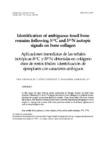Mostrar o rexistro simple do ítem
Identification of ambiguous fossil bone remains following 13C and 15N isotopic signals on bone collagen
| dc.contributor.author | Vila, Marta | |
| dc.contributor.author | López González, F. | |
| dc.contributor.author | Grandal-d'Anglade, Aurora | |
| dc.date.accessioned | 2010-01-25T09:38:22Z | |
| dc.date.available | 2010-01-25T09:38:22Z | |
| dc.date.issued | 2001 | |
| dc.identifier.citation | Cadernos do Laboratorio Xeolóxico de Laxe, 2001, 26: 281-288 ISSN: 00213-4497 | es_ES |
| dc.identifier.issn | 0213-4497 | |
| dc.identifier.uri | http://hdl.handle.net/2183/6509 | |
| dc.description.abstract | [Abstract] In this paper we deal with an useful application of isotopic studies on fossil bone remains. Following δ1 3C and δ1 5N signals recorded in bone collagen, it is possible to classify into the proper taxon some doubtful remains. Thus, three fossil ribs from Liñares site (Galicia, NW Iberian Peninsula) have been correctly classified as belonging to Cervus elaphus L., taking into account both some previous works on its isotopic signatures as well as morphological data. | |
| dc.language.iso | eng | es_ES |
| dc.publisher | Universidade da Coruña | es_ES |
| dc.subject | Ursus spelaeus | es_ES |
| dc.subject | Cervus elaphus | es_ES |
| dc.subject | Ursus arctos | es_ES |
| dc.subject | Stable isotopes | es_ES |
| dc.subject | D1 3C | es_ES |
| dc.subject | D1 5N | es_ES |
| dc.title | Identification of ambiguous fossil bone remains following 13C and 15N isotopic signals on bone collagen | es_ES |
| dc.title.alternative | Aplicaciones inmediatas de las señales isotópicas δ13C y δ15N obtenidas en colágeno óseo de restos fósiles: identificación de ejemplares con caracteres ambiguos | |
| dc.type | info:eu-repo/semantics/article | es_ES |
| dc.rights.access | info:eu-repo/semantics/openAccess |






